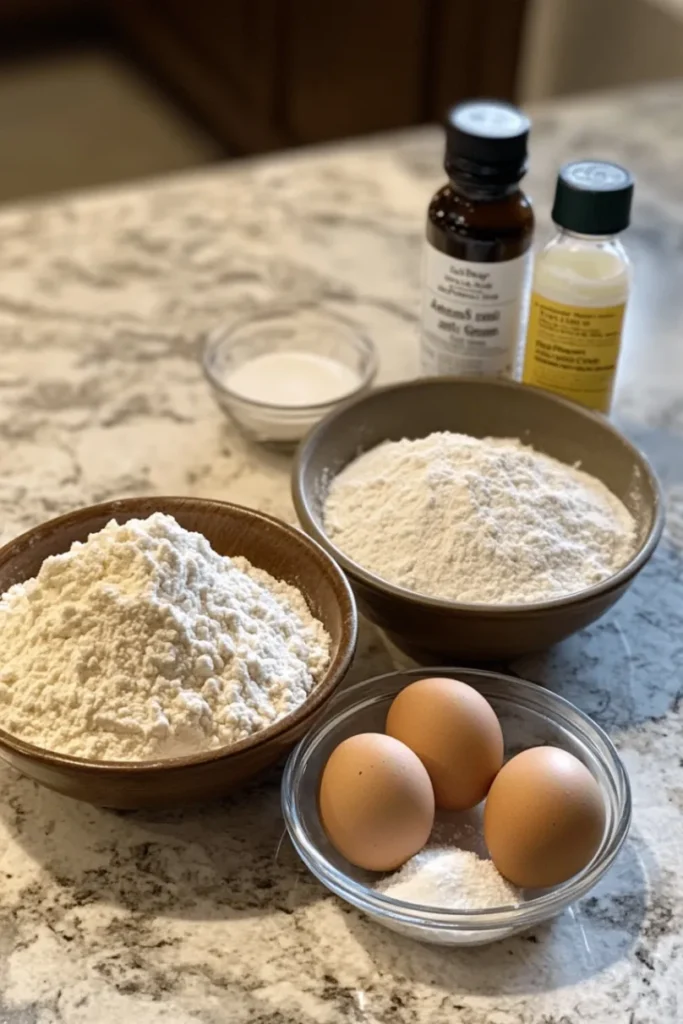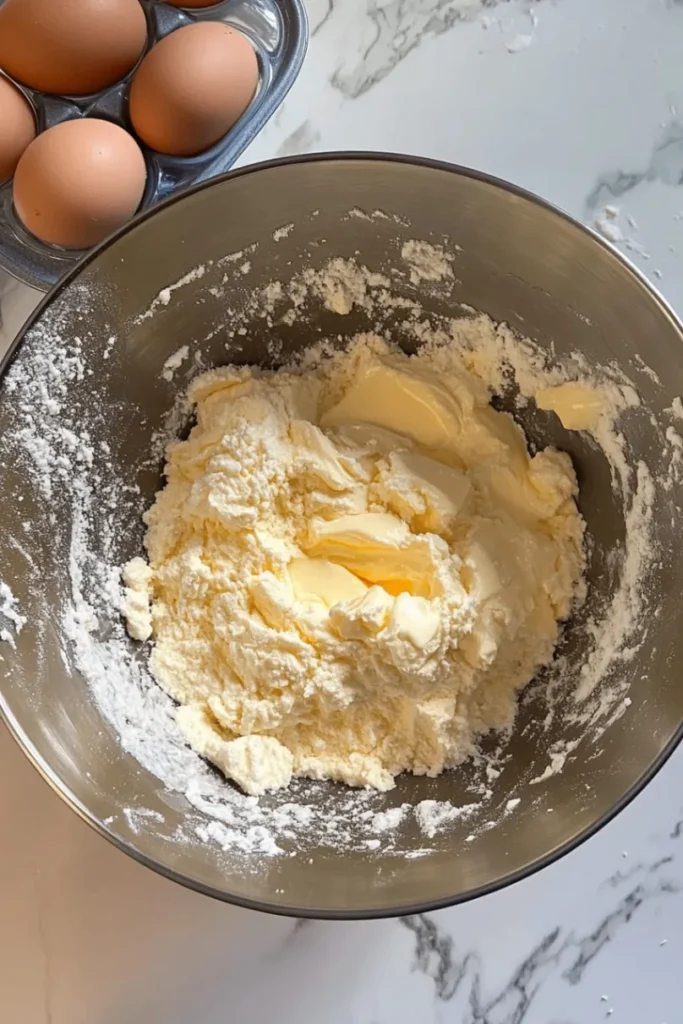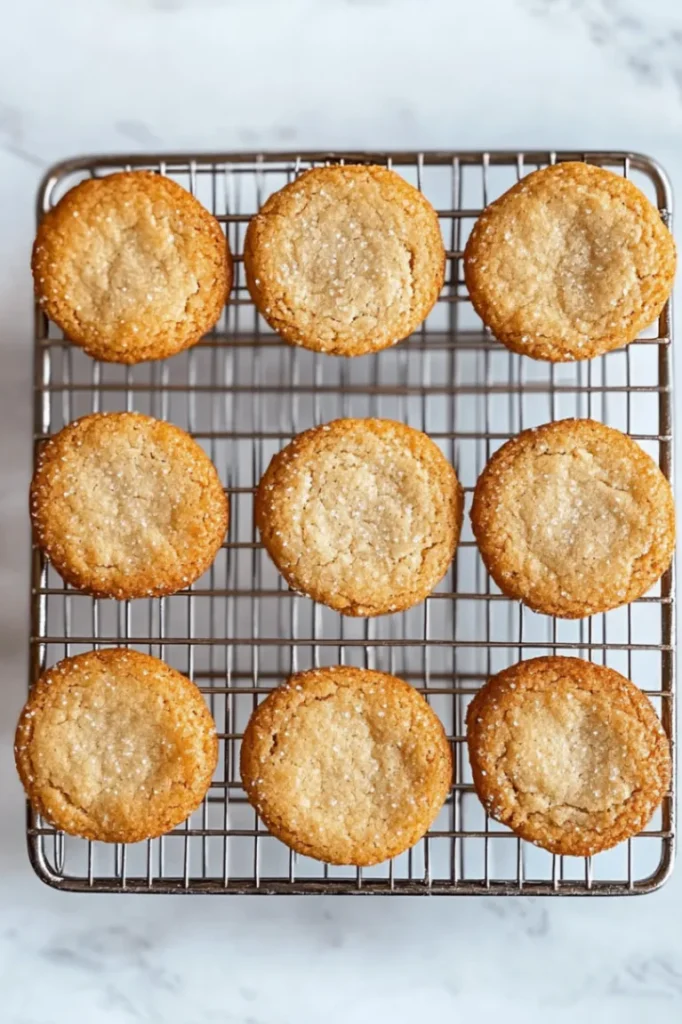Table of Contents
My first taste of a French cookie came from a friend during a stroll through Paris. Delicate, buttery, and instantly unforgettable, that moment sparked a lasting love for these elegant treats. Now, each time I bake them, it’s like revisiting that sweet memory. And today, I’m excited to share a piece of it with you.
Key Benefits of French Cookies
- Authentic Flavor Experience
French cookies are synonymous with subtle yet captivating flavors. They often rely on classic pantry staples like butter, sugar, and flour to produce a taste that’s delicately sweet and undeniably sophisticated. - Versatile Treat
Whether you want to serve them as an afternoon pick-me-up or as a small indulgence after a savory meal, French cookies fit any occasion seamlessly. They can be dressed up with a chocolate drizzle for festive gatherings or kept delightfully simple for an everyday snack. - Rich Culinary Heritage
According to pastry experts at the Culinary Institute of America, French pastries and cookies carry centuries of tradition. This makes them a wonderful way to connect with the historic artistry behind French baking, right in the comfort of your own kitchen. - Easy to Customize
A fantastic perk of baking French cookies is the ease with which you can adapt them to personal preferences. For instance, if you enjoy hints of citrus, incorporating lemon zest can transform the flavor profile. Similarly, those seeking a nutty crunch can mix in finely chopped almonds or hazelnuts. - Impressive Yet Simple
One might assume that anything labeled “French” is complicated. However, French cookies are surprisingly beginner-friendly. Their easy instructions, combined with high-quality ingredients, can yield professional-looking (and tasting) results without extensive culinary expertise.
Ingredients
Below is a convenient table that outlines each ingredient needed. I’ve also included short notes to guide you in selecting quality items and making simple adjustments:
| Ingredient | Quantity | Notes |
|---|---|---|
| All-Purpose Flour | 2 cups (about 240g) | Sift before measuring for a smoother texture |
| Sugar (Granulated) | ¾ cup (about 150g) | Opt for pure vanilla for a deeper, richer aroma |
| Unsalted Butter | 1 cup (2 sticks) | Softened, not melted, to ensure smooth blending |
| Eggs (Large) | 2 | Room temperature helps achieve an even mix |
| Salt | ½ teaspoon | Elevates flavor without overpowering sweetness |
| Baking Powder (Optional) | ½ teaspoon | Adds a fluffier texture if you prefer airy cookies |
| Vanilla Extract | 1 teaspoon | Opt for pure vanilla for deeper, richer aroma |

Ingredient Selection Tips:
- When possible, choose high-quality butter that has a low moisture content. This typically results in a richer taste and more delicate crumb.
- Sifting the flour ensures minimal lumps, making your cookie dough smooth and consistent.
- Using room-temperature eggs helps bind the dough more effectively, reducing any risk of clumpy batter.
With these ingredients in hand, you’re well on your way to creating soft, buttery french cookies. They’re not just delicious they’re also rooted in a proud culinary tradition that anyone can master. By carefully selecting each component, you’ll discover how a little attention to detail can transform basic pantry items into heavenly bites of joy. And don’t worry if you’re new to baking trust me, these cookies are far more forgiving than their elegant name might suggest!
Step-by-Step Instructions
When it comes to achieving bakery-quality French cookies right in your own kitchen, a clear, organized process is your best friend. Below, I’ve broken down the method into three main steps. Each step focuses on a specific phase of the recipe, ensuring you can follow along smoothly without confusion.
Step 1: Prepare the Dough
- Cream the Butter and Sugar
- Begin by placing your softened unsalted butter and sugar into a large mixing bowl.
- Using a hand mixer or stand mixer, beat the mixture on medium speed until it appears light and fluffy. This process can take around 2–3 minutes, so be patient. The goal here is to incorporate tiny air pockets into the butter, which gives the cookies their signature airy texture.
- Keep an eye on the sides of the bowl pause occasionally to scrape down any butter or sugar clinging to the edges so everything mixes evenly.
- Begin by placing your softened unsalted butter and sugar into a large mixing bowl.
- Incorporate the Eggs and Vanilla
- Crack in both of your room-temperature eggs one at a time, mixing well after each addition.
- Pour in the vanilla extract to infuse the dough with a warm, fragrant note.
- Continue mixing until you see no streaks of egg remaining. Your dough should be a creamy, pale yellow by now.
- Crack in both of your room-temperature eggs one at a time, mixing well after each addition.
- Combine the Dry Ingredients
- In a separate bowl, whisk together the all-purpose flour, salt, and (if desired) baking powder. Sifting can help remove any lumps, making the dough smoother.
- Gradually add the dry mixture to the wet ingredients, blending just until the dough comes together. Be careful not to overmix; too much stirring can make your cookies tough.
- At this point, the dough might be slightly sticky but should hold its shape when pressed gently.
- In a separate bowl, whisk together the all-purpose flour, salt, and (if desired) baking powder. Sifting can help remove any lumps, making the dough smoother.

Step 2: Shape and Chill
- Shape the Dough
- You can shape these cookies in a variety of ways. Some prefer rolling them into small balls and flattening them gently for a classic, rounded cookie. Others enjoy using a piping bag with a large star tip to create more intricate designs.
- Whichever route you take, consistency in size is key. Aim for uniform thickness so that your cookies bake evenly.
- You can shape these cookies in a variety of ways. Some prefer rolling them into small balls and flattening them gently for a classic, rounded cookie. Others enjoy using a piping bag with a large star tip to create more intricate designs.
- Chill Time
- Once shaped, place the cookie dough on a baking sheet lined with parchment paper.
- Slide the entire sheet into the refrigerator to allow the dough to chill for at least 30 minutes. Chilling is crucial because it helps the butter re-solidify, preventing excessive spreading in the oven.
- If you’re pressed for time, a quick freeze for 10–15 minutes can work, but be mindful that a longer chill generally delivers better results.
- Once shaped, place the cookie dough on a baking sheet lined with parchment paper.
- Preheat the Oven
- As the dough chills, set your oven to 350°F. Giving the oven ample time to warm up ensures a stable temperature once you pop in your cookies.
- Prepare an additional baking sheet or two with parchment paper so you can seamlessly transition to the baking process.
- As the dough chills, set your oven to 350°F. Giving the oven ample time to warm up ensures a stable temperature once you pop in your cookies.

Step 3: Bake and Cool
- Bake the Cookies
- Remove the chilled dough from the fridge and place the shaped cookies on your prepared baking sheets. Keep about two inches of space between each cookie.
- Bake in the preheated oven for approximately 10–12 minutes, or until the edges turn a light golden color. Every oven is a bit different, so monitor them closely toward the end of the baking cycle.
- Remove the chilled dough from the fridge and place the shaped cookies on your prepared baking sheets. Keep about two inches of space between each cookie.
- Cool on a Rack
- Carefully remove the baking sheets from the oven and allow the cookies to rest for a minute or two on the tray. They’ll be delicate right out of the oven, so give them a moment to set.
- Transfer the cookies to a wire rack to cool completely. This helps them maintain their shape and crispy edges.
- Once they reach room temperature, your French cookies are ready to be enjoyed.
- Carefully remove the baking sheets from the oven and allow the cookies to rest for a minute or two on the tray. They’ll be delicate right out of the oven, so give them a moment to set.

Recipe Variations
One of the joys of this recipe is how easily you can personalize it. Below are a few suggestions for different flavor profiles, each adaptable to suit your preferences:
- Chocolate Drizzle
- Melt a handful of high-quality chocolate chips in a microwave-safe bowl (using 15-second intervals to avoid scorching).
- Once the cookies have cooled, drizzle the melted chocolate on top. Let it harden for a sweet, decorative finish.
- Melt a handful of high-quality chocolate chips in a microwave-safe bowl (using 15-second intervals to avoid scorching).
- Nutty Crunch
- Add chopped almonds, hazelnuts, or pecans to the dough for extra texture.
- Tossing nuts in a bit of flour before mixing them into the dough can help keep them evenly distributed.
- Add chopped almonds, hazelnuts, or pecans to the dough for extra texture.
- Citrus Zest
- Grate fresh lemon or orange zest into the creamed butter and sugar before adding any other ingredients.
- The pop of citrus offers a bright complement to the buttery richness of the cookies.
- Grate fresh lemon or orange zest into the creamed butter and sugar before adding any other ingredients.
- Spiced Twist
- A pinch of cinnamon or cardamom can lend a pleasant warmth.
- Start with half a teaspoon to avoid overpowering the delicate flavor of the cookies.
- A pinch of cinnamon or cardamom can lend a pleasant warmth.
- Coffee-Infused
- Dissolve a small amount of instant coffee granules in a teaspoon of hot water, then blend them into the butter-sugar mixture.
- The resulting cookies offer a subtle java aroma perfect for pairing with a morning latte.
- Dissolve a small amount of instant coffee granules in a teaspoon of hot water, then blend them into the butter-sugar mixture.
No matter which variation you select, the core technique remains the same. That dependable dough foundation ensures each cookie remains light, delicate, and undeniably French in essence. By experimenting with different tastes and styles, you can craft a unique cookie collection that will charm guests and satisfy your sweet tooth. Best of all, you don’t need professional training to pull off these elegant results. A little creativity and plenty of willingness to taste-test go a long way in perfecting your signature batch of French cookies.
Serving Suggestions
After you’ve put care into crafting your French cookies, deciding how to serve them can add an extra layer of enjoyment. These delicate sweets are surprisingly flexible in how they pair with beverages and other dishes. Below are a few ideas to spark your imagination:
- Tea or Coffee Pairing
- Enjoying these cookies with a hot cup of tea or coffee highlights their buttery goodness. A soothing herbal tea plays beautifully against the sweetness, while a bold coffee brings out deeper notes in the dough.
- Enjoying these cookies with a hot cup of tea or coffee highlights their buttery goodness. A soothing herbal tea plays beautifully against the sweetness, while a bold coffee brings out deeper notes in the dough.
- Eye-Catching Dessert Tray
- Arrange your freshly baked cookies alongside fresh berries, whipped cream, or a bowl of chocolate sauce. This visual variety adds a sense of occasion and allows guests to customize their dessert experience with different flavor combinations.
- Arrange your freshly baked cookies alongside fresh berries, whipped cream, or a bowl of chocolate sauce. This visual variety adds a sense of occasion and allows guests to customize their dessert experience with different flavor combinations.
- Fruity Contrasts
- Incorporate sliced strawberries, peaches, or other seasonal fruits for a refreshing addition. The mild tartness of fresh fruit balances the cookies’ subtle richness, creating a light yet indulgent treat.
- Incorporate sliced strawberries, peaches, or other seasonal fruits for a refreshing addition. The mild tartness of fresh fruit balances the cookies’ subtle richness, creating a light yet indulgent treat.
- Simple Afternoon Snack
- Sometimes all you need is a quick boost in the middle of a busy day. Pair one or two cookies with a glass of milk (or almond milk) for a comforting moment that revives both energy and spirit.
- Sometimes all you need is a quick boost in the middle of a busy day. Pair one or two cookies with a glass of milk (or almond milk) for a comforting moment that revives both energy and spirit.
Tips for Success
No matter how experienced you are in the kitchen, these pointers can help maintain the delightful texture and taste of French cookies:
- Choose Quality Ingredients
Whenever possible, use premium butter and fresh flour. The difference in flavor and outcome is often noticeable with high-quality essentials. - Chill Your Dough
Once you’ve formed or piped your dough, a cool rest in the refrigerator is critical. This step helps the butter solidify, reducing the likelihood that your cookies will flatten too much in the oven. - Keep an Eye on Baking Time
Every oven behaves differently, so begin checking for doneness around the 8–10 minute mark. The best texture often appears when the edges are just beginning to turn lightly golden. - Use Parchment Paper or Silicone Mats
This simple step helps cookies bake evenly and prevents them from sticking to the tray. It also makes cleanup a breeze. - Adapt for Your Environment
In humid areas, you may need slightly more flour to counteract extra moisture in the dough. Conversely, drier climates might call for a small reduction in flour to keep your cookies from becoming crumbly.
Additional Valuable Section
Immerse Yourself in French Baking Culture
- Embrace the spirit of French pâtisserie by exploring various techniques and flavor infusions. Incorporating local, seasonal produce can deepen your connection to this storied culinary heritage.
- Sharing freshly baked French cookies is also a heartfelt way to introduce loved ones to a slice of European tradition. Whether you box them up as a thoughtful gift or serve them on a refined dessert stand, you’re capturing a bit of France in each bite.
Customize for Personal Touches
Don’t be afraid to get creative. A sprinkle of powdered sugar, a drizzle of melted chocolate, or even a zest of citrus can transform classic cookies into your own signature treat. Small edits like these encourage you to keep experimenting, learning, and having fun with your baking.
Frequently Asked Questions (FAQ)
1. What is the famous French cookie?
The macaron often takes the spotlight as the most famous French cookie. These delicate sandwich-style treats feature a crisp exterior and a chewy center, showcased in flavors like pistachio, vanilla, or salted caramel.
2. What are the little French cookies called?
Bite-sized French confections are frequently referred to as “petits fours,” but that term can also encompass small cakes. Macarons, madeleines, and financiers are examples of popular mini French treats celebrated for their light texture and tasteful presentation.
3. What makes french cookies different from other cookies?
French cookies often emphasize balance and subtlety. Their recipes highlight quality butter, exacting technique, and a level of sweetness that complements rather than overpowers.
4. How do I store my french cookies?
To maintain flavor and texture, store them in an airtight container at room temperature. They typically retain their fresh taste for about a week. Slip in a small piece of bread if you’d like to preserve some softness.
5. Why did my cookies spread too much?
Often, insufficient chilling or overly warm butter is to blame. Ensuring the dough is well-refrigerated prior to baking typically resolves this issue.
6. Are there dairy-free or gluten-free options?
Yes. Plant-based butter substitutes work well in this recipe, and a 1:1 gluten-free flour mix can be used if you want a wheat-free version. Be prepared to adjust baking times slightly to achieve the desired consistency.
Conclusion
French cookies encapsulate a timeless allure and unmatched comfort that can bring warmth to any gathering. Whether you enjoy them solo with a soothing cup of tea or dress them up on a decadent dessert platter, these cookies strike a balance between refinement and everyday indulgence. The real beauty lies in how approachable the recipe is you don’t need a professional kitchen or advanced skills to produce stellar results. With a bit of patience, a dash of creativity, and a sense of curiosity, you’ll soon be delighting friends, family, and perhaps even yourself with the irresistible charm of homemade French cookies.
Print
French Cookies
- Total Time: 27 minutes
- Yield: About 24 cookies
- Diet: Vegetarian
Description
These delicately crisp and irresistibly buttery French cookies capture the essence of a classic patisserie treat. Perfect with a cup of tea or coffee, they’re an elegant yet simple indulgence that’s surprisingly easy to bake at home.
Ingredients
Cookie Dough
2 cups (about 240 g) all-purpose flour, sifted
¾ cup (150 g) granulated sugar
1 cup (2 sticks) unsalted butter, softened
2 large eggs, room temperature
½ teaspoon salt
½ teaspoon baking powder (optional, for a lighter texture)
1 teaspoon vanilla extract
Instructions
Cream the Butter and Sugar
In a mixing bowl, cream the softened butter and sugar together using a hand mixer (or stand mixer) on medium speed.
Continue until the mixture is light and fluffy, about 2–3 minutes.
Incorporate Eggs and Vanilla
Beat in the eggs one at a time, ensuring each egg is fully incorporated before adding the next.
Add the vanilla extract, mixing briefly to combine.
Combine Dry Ingredients
In a separate bowl, whisk together the flour, salt, and optional baking powder.
Slowly add the dry mixture to the creamed butter mixture. Mix on low speed until just combined; avoid overmixing.
Shape and Chill
Gather the dough into a ball, wrap in plastic wrap, and place in the fridge for at least 30 minutes.
Chilling helps the dough firm up, ensuring the cookies hold their shape when baked.
Preheat and Prepare
Preheat your oven to 350°F (175°C).
Line one or two baking sheets with parchment paper.
Form the Cookies
Remove the dough from the fridge and roll it to about ¼-inch thickness on a lightly floured surface.
Use a cookie cutter or simply shape small rounds. Arrange them on the baking sheets, leaving about 2 inches between each cookie.
Bake
Place the baking sheets on the middle rack of the oven.
Bake for 10–12 minutes or until the edges turn a light golden brown. Baking time may vary depending on your oven.
Cool and Enjoy
Carefully remove the cookies from the oven. Let them rest for 1 minute on the baking sheets before transferring to a wire rack to cool completely.
Enjoy with a cozy beverage or store in an airtight container for later.
Notes
✔ Optional Flavors: For a citrus twist, add 1 tablespoon of lemon or orange zest to the butter-sugar mixture.
✔ Storage: Keep cookies in an airtight container at room temperature for up to a week.
✔ Dough Freezing: You can freeze unbaked dough discs for up to 3 months. Thaw overnight in the fridge before baking.
✔ Baking Powder: If you prefer a denser texture, skip the baking powder; for a slightly lighter cookie, include it
- Prep Time: 15 minutes
- Cook Time: 12 minutes
- Category: Dessert
- Method: Baking
- Cuisine: French
Nutrition
- Serving Size: 1 cookie
- Calories: 95
- Sugar: 6 g
- Sodium: 65 mg
- Fat: 5 g
- Carbohydrates: 11 g
- Protein: 1 g
Keywords: french cookies, butter cookies, easy desserts, homemade treats, French baking, tea-time snacks


1 thought on “French Cookies”